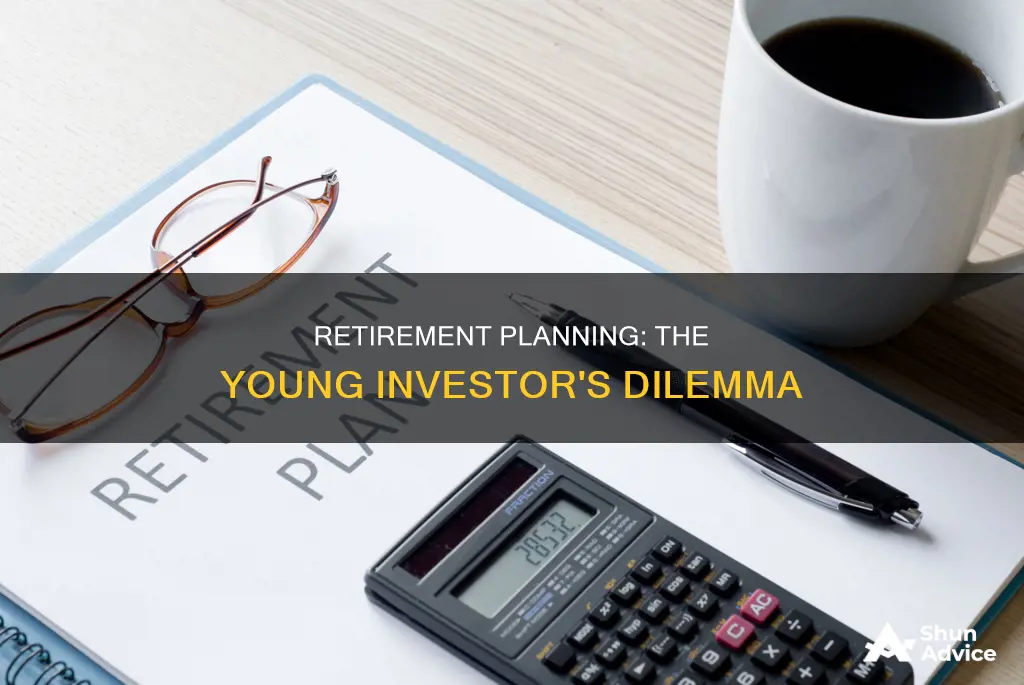
Investing for retirement at a young age is a great way to build wealth over time. While it can be challenging for young people to invest due to limited disposable income and unexpected expenses, the power of compound interest means that even small, regular contributions to a retirement fund can grow into a substantial sum over several decades.
Young investors have time on their side, and this is a valuable resource when it comes to investing. The earlier someone starts putting money away, the less they will need to contribute overall. For example, investing $2,000 a year from age 19 to 27 and then stopping contributions would result in $1 million in savings by age 65, assuming a 10% average rate of return. Waiting until age 27 to start saving and then saving for 38 years would result in $800,000 by age 65—a difference of $200,000.
There are several options for young people looking to start investing for retirement, including Individual Retirement Accounts (IRAs), 401(k) plans, and real estate.
| Characteristics | Values |
|---|---|
| Time | Young investors have time on their side. |
| Compound Interest | Compound interest is the best reason to start saving early. |
| Risk | Younger investors can tolerate more risk. |
| Income | Younger investors have less income to invest. |
| Retirement Accounts | IRAs and employer-sponsored retirement plans are great ways to start saving for retirement. |
| Investment Options | Stocks, real estate, and mutual funds are some of the investment options for young investors. |
| Financial Advice | It may be necessary to hire a financial advisor to help with retirement planning. |
What You'll Learn

Compound interest and tax advantages
Investing for retirement at a young age has the potential to bring significant benefits in the long run. One of the greatest advantages people in their 20s have is time, and time is positively correlated with the power of compounding interest. The earlier you start investing, the more time your money has to grow.
For example, let's say you start contributing $1,000 annually at the age of 25 for just ten years, assuming an 8% rate of return. By the time you're 65, your investment would have grown to $157,435. On the other hand, if you wait until you're 35 and contribute the same amount for thirty years, you'll end up with only $122,346. This dramatic difference is due to the power of compound interest.
Compound interest is when the interest you earn on your initial investment also earns interest over time, leading to exponential growth. The longer your money is invested, the more it grows, and the faster it compounds. This is why starting early with retirement planning is so important.
Another advantage of investing for retirement at a young age is the tax benefits associated with certain types of retirement accounts. For example, with a traditional Individual Retirement Account (IRA), you can deduct your contributions from your taxable income, meaning you pay less in taxes. The money in an IRA also grows tax-free until you withdraw it in retirement.
Alternatively, you could invest in a Roth IRA, which is funded with post-tax income. While you don't get an immediate tax deduction, the money grows tax-free, and you don't owe any taxes when you withdraw it in retirement. This can be especially beneficial if you expect to be in a higher tax bracket in the future.
In conclusion, investing for retirement at a young age allows you to take advantage of compound interest and provides tax benefits that can help your savings grow over time. The key is to start early, be consistent, and seek professional advice when needed.
The Workforce Investment Act: Funding America's Future
You may want to see also

Retirement accounts
K) Retirement Plan
A 401(k) is a retirement plan offered by employers to their employees. It allows you to invest on a tax-deferred basis, meaning you don't pay taxes on the money you put into the plan until you withdraw it. Many employers will match a certain percentage of your salary or contributions, giving your retirement savings a boost. The annual contribution limit for a 401(k) is $23,000 in 2024.
Individual Retirement Account (IRA)
An IRA is a retirement account that individuals can contribute to on their own, regardless of whether their employer offers a retirement plan. There are two types of IRAs: the traditional IRA and the Roth IRA. Traditional IRAs are tax-deferred, meaning you contribute pre-tax dollars, which grow tax-free. You pay taxes when you withdraw the money. For 2024, the contribution limit for a traditional IRA is $7,000.
Roth IRA
With a Roth IRA, you pay taxes on your contributions upfront, but then your savings grow tax-free, and you don't pay taxes when you withdraw the money in retirement. There are income limits for contributing to a Roth IRA, and you must make less than $144,000 as an individual or $204,000 as a married couple. The contribution limit for a Roth IRA is the same as for a traditional IRA: $7,000 in 2024.
Other Retirement Accounts
There are also other types of retirement accounts, such as 403(b) plans, which are similar to 401(k)s but are offered to certain educators, public employees, and employees of nonprofits. Additionally, there are SIMPLE IRAs, which are great investment choices if your employer will match your contributions.
It's important to consider your own financial situation and goals when choosing a retirement account. A financial advisor can help you navigate the different options and determine which one is best for you.
Retirement Plans: Navigating the Investment Danger Zone
You may want to see also

Employer-matching contributions
The amount that an employer matches varies. Some employers offer 100% matching contributions, while others don't match anything. A 50% match is common. The matching contribution is usually a percentage of the employee's contribution or the elective-deferral contributions they make. For example, an employer might match 50% of an employee's contribution. This means that if an employee contributes $1,200 from their $30,000 annual salary to their company's retirement plan, their employer's 50% match would result in an additional $600 being added to their retirement account for the year.
It's important to note that employer-matching contributions are not the same as regular deferrals, which are contributions that employers may choose to make to employee plans regardless of employee contributions. Employer-matching contributions are also different from non-matching contributions, which are contributions that employers can make to an employee's 401(k) retirement savings account even if the employee doesn't contribute.
When deciding how much to contribute to take advantage of employer-matching contributions, it's important to refer to the terms of your specific plan. The retirement plan information provided by your employer will outline how long you need to work for the company before receiving these contributions, the matching formula, and how much you need to contribute to fully benefit from the match.
By taking advantage of employer-matching contributions, you can boost your retirement savings potential and set yourself up for financial success in the future.
Elon Musk's Current Investment Focus
You may want to see also

Risk and volatility
When it comes to investing, there is always an element of risk and volatility to consider. This is especially true for young investors who are just starting to build their investment portfolios. While taking on risk can lead to higher returns, it is important to understand and manage these risks effectively. Here are some key considerations regarding risk and volatility for young investors:
Time Horizon and Risk Tolerance
Young investors typically have a longer time horizon, which means they have more time to ride out market fluctuations and recover from potential losses. As a result, they can generally afford to take on more risk in their investment portfolios. This may involve allocating a larger portion of their portfolio to stocks and other growth-oriented investments, which tend to be more volatile but offer higher potential returns over the long term.
Diversification
Diversification is a crucial risk management strategy for investors of all ages. By diversifying their portfolios across different asset classes, sectors, and industries, young investors can reduce the impact of market volatility on their overall portfolio. For example, investing in a variety of stocks from different sectors can help mitigate the risk of losing money if a particular stock or industry underperforms. Diversification ensures that the performance of a single investment does not disproportionately affect the entire portfolio.
Understanding Risk
It is essential for young investors to understand the risks associated with different types of investments. While stocks may offer higher potential returns, they also come with higher risk and volatility. On the other hand, bonds and fixed-income investments are generally less risky but may provide lower returns. Young investors should assess their risk tolerance and investment goals when deciding how to allocate their portfolio across different asset classes.
Speculation vs. Investing
Young investors should distinguish between speculation and investing. Speculation involves taking highly speculative trades or gambling on big payoffs, which can lead to significant losses. Instead, young investors should focus on investing in solid companies with long-term upside potential. Index funds or diversified portfolios can be a good option for those who want a simpler approach.
Leverage
Leverage can amplify both gains and losses in an investment portfolio. While young investors can consider using leverage due to their longer time horizon, it should be done cautiously and in moderation. A large drop in portfolio value due to excessive leverage may discourage a young investor and make them overly risk-averse in the future. It is important to understand the risks and potential impact on the overall portfolio before employing leverage.
Education and Research
Young investors should educate themselves about investing and conduct thorough research before making investment decisions. Understanding the basics of investing, different asset classes, and market risks can help in making informed choices. Asking questions and seeking advice from financial advisors or experienced investors can also help mitigate risks.
In conclusion, while investing at a young age comes with certain risks and volatility, it is important for young investors to understand and effectively manage these risks. By considering their time horizon, risk tolerance, and investment goals, young investors can build a well-diversified portfolio that maximizes returns while managing volatility. Starting early and adopting a long-term perspective can help smooth out the impact of short-term market fluctuations.
REITs: A Smart Real Estate Investment?
You may want to see also

Long-term goals
Retirement may seem like a distant prospect when you're in your twenties, but it's important to start saving early. The earlier you begin, the less you'll need to contribute each month, thanks to compound interest. This is the interest earned on your initial savings and the reinvested earnings. The longer your money is invested, the more it will grow.
When you're young, you have more time to take risks with your investments. You can afford to be aggressive and focus on growth. Stocks and real estate are good options for long-term goals as they tend to gain value faster than the rate of inflation.
If your employer offers a 401(k) or similar retirement plan, take advantage of it, especially if they will match your contributions. This can give your retirement savings a tremendous boost.
You can also open a Roth IRA, which is another tax-advantaged retirement account. With a Roth IRA, you pay taxes on your contributions upfront, and then your savings grow tax-free. There are income limits for opening a Roth IRA, so check if you are eligible.
If you're not sure where to start, consider hiring a financial advisor to help you set realistic goals and create a plan.
Investing Together, Retiring Together: A Couple's Guide to Financial Freedom
You may want to see also
Frequently asked questions
The earlier you start putting money away, the less you'll need to contribute later. Investing in your twenties will give your savings several decades to grow.
Young investors have the most valuable resource on their side: time. Your primary investment objective for long-term savings should be growth. Consider putting as much of your savings as possible in some form of equities, such as common stocks and stock mutual funds. Real estate and stocks both tend to gain value faster than the rate of inflation. IRAs and employer-sponsored retirement plans are great ways to start saving for retirement.
In general, it is a good idea to save 10% to 15% of your income, but even saving less is better than not saving at all.







